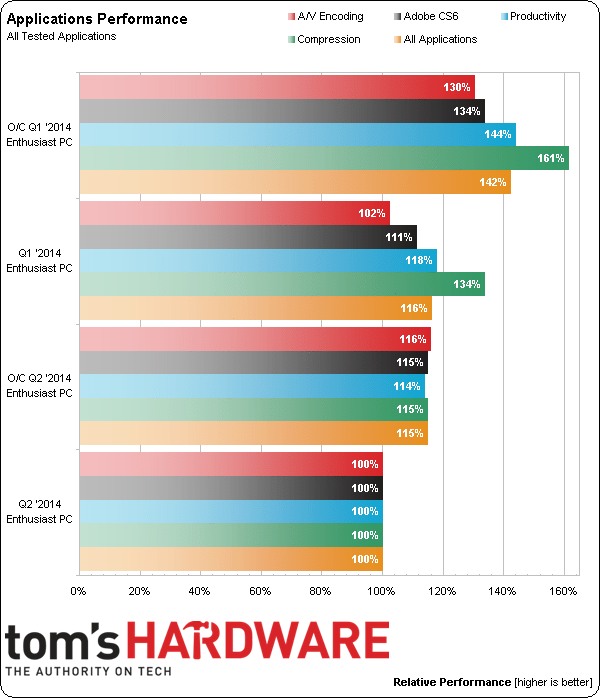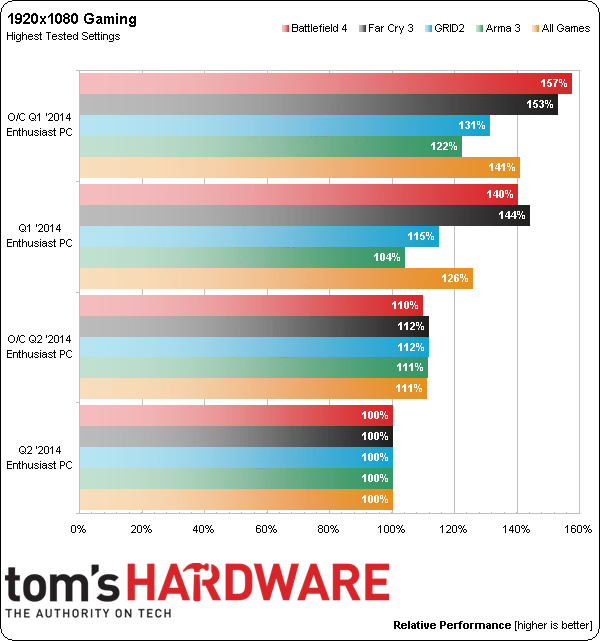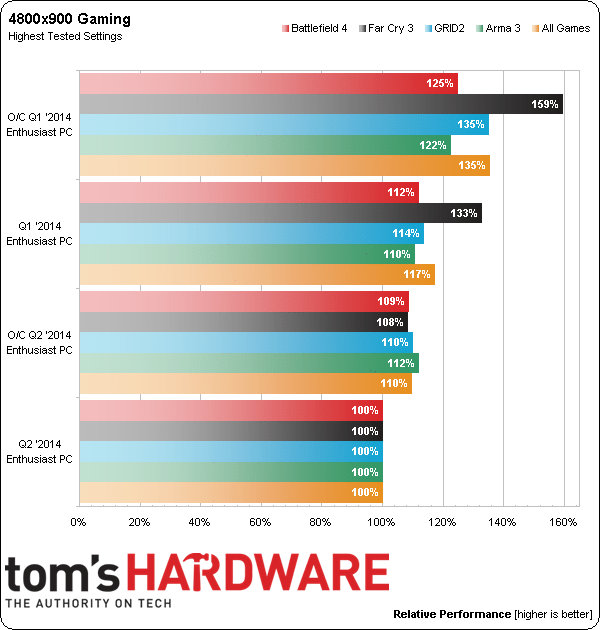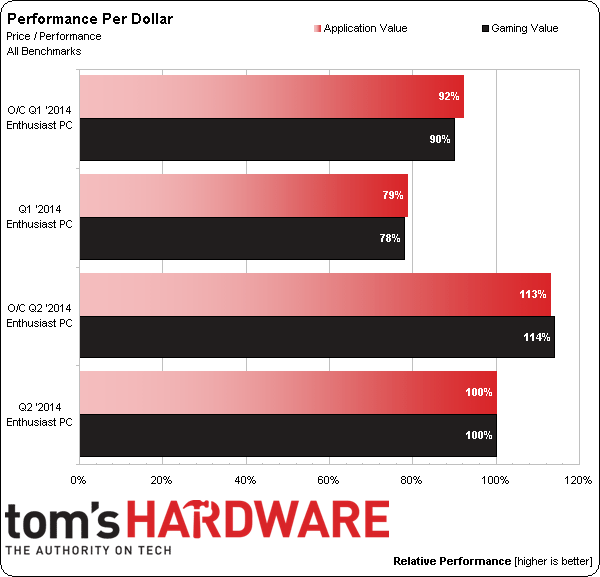System Builder Marathon, Q2 2014: Our Enthusiast PC
A Core i5-4670K And Radeon R9 290 Offer Big Value
For the second quarter of 2014, I stepped down from a Core i7 and GeForce GTX 780 Ti to a Core i5 and Radeon R9 290. As a result, I used about $500 less in performance parts this time around.
Was the loss in performance compensated for by an increase in value? We need to run our numbers through a handful of calculations before we can tell you. I'll start with a look at the application performance, since this configuration isn't explicitly a gaming-oriented build.
Compared to a stock Core i7-4770K, the Core i5-4670K isn't too far off. Overclocked, the i5 almost achieves parity, in fact. Only the file compression tools we benchmark with really favor Intel's Hyper-Threaded Core i7.
Of course, the Core i7-4770K walks away again once it's overclocked as well. But when there's such a big cost disparity, we have to expect a corresponding performance delta.
How do those numbers compare to our gaming results? Let's look:
At 1920x1080, the GeForce GTX 780 Ti is incredibly strong. As we shift over to the triple-monitor resolution, Nvidia's GK110 is still faster, but seemingly less so. When overclocking is applied to the Radeon R9 290, it comes close to catching the GeForce-equipped system in stock form. Again, that's not bad for a build with less expensive hardware.
Comparing price and performance gives us a value determination that makes this quarter's mid-range machine look good. Are we surprised that cutting so much from our budget, yet retaining the overclockable Core i5 and Radeon R9 290, helps enable favorable speed for a little over $1000 worth of critical platform parts? Of course not. We've been recommending this Intel CPU and AMD graphics card for months (except for that bit where prices on Hawaii-based boards were out of control).
Get Tom's Hardware's best news and in-depth reviews, straight to your inbox.
The outcome would have been even more impressive if the Radeon wasn't still bouncing all over the place. We ordered it under $400. PowerColor's card then jumped up closer to $500. At least, for this very moment, it's back down to $430 on Newegg and includes a 250 GB Samsung 840 EVO SSD that instantly overcomes my configuration's biggest weakness. Talk about a roller coaster ride of emotions. Really though, the Core i5 and Radeon R9 290 represent the best bang for your buck when it comes to enthusiast-class hardware right now.
In a couple of days, Thomas is going to compare the value of my configuration to Paul's specifically budget-oriented setup and his own high-end PC. If the price on PowerColor's card holds, I think I have a pretty good chance at scoring an all-around win.
Current page: A Core i5-4670K And Radeon R9 290 Offer Big Value
Prev Page Power And TemperatureDon Woligroski was a former senior hardware editor for Tom's Hardware. He has covered a wide range of PC hardware topics, including CPUs, GPUs, system building, and emerging technologies.
-
BilinearCheese I have to say guys, that enthusiast level build is terrible. Apevia case? Turbo Duo 290? NO SSD? Come on. For 16 bucks less I put together a system WITH an SSD, a decent case, a much better 290, and a better motherboard/cpu cooler. Hell, I even managed to get a color scheme together for it as well:Reply
http://pcpartpicker.com/p/FRyNgs
"Terrible" = same CPU, cooler, graphics card, and equal benchmark performance?
The case we chose really doesn't matter, as the first page of article points out. Case/optical drive is completely subjective. That's exactly why we've separated the performance parts price from case/optical/OS.
By the way, are you just assuming Apevia its bad because you prefer other well-known brands? It did a fantastic job for the purposes of this article, so other than brand, what's your issue with it? Is brand the same problem you have with the 290? Because it's cooler is quite good.
Speaking of coolers, the Hyper 212 EVO is virtually the 212 plus with a different fan. Is this really the huge difference you're implying it is?
You're also specing it out two months after we did, with lower prices. An SSD would have been great, but two months ago when we ordered there was no room in the budget, and we weren't willing to sacrifice the 290.
Bottom line, you're being a little sensationalist about picking nits. -
itzsnypah When overclocking the CPU are you leaving the uncore coupled to the core multiplier or uncoupled and set at x34/36? You averaging nearly 1.3v for only 4.3Ghz is very poor.Reply -
I have to question the need for Z97 mobo. If you go with the Haswell and not the Haswell update and you do not include M.2 SSD, then why go with Z97? If you are choosing the Z97 to have a upgrade path, you should also go for the Devil's Canyon cpu. Budget-wise it is a really bad idea to even think about going for D.C. Haswell chip later on.Reply
The ssd gives you an easily felt sensation of speed every time you boot. Just got an ssd myself like 2 months ago. Any other go-fast parts come secondary. Ditch the Z97 and the ODD and you could squeeze in a SSD. -
envy14tpe @BilinearCheese. I believe all parts for these toms' builds have to be from Newegg. So, try building that way.Reply -
BilinearCheese Reply@BilinearCheese. I believe all parts for these toms' builds have to be from Newegg. So, try building that way.
How is this the best suggested build for the money if you're only locking it to one retailer? That's...kinda silly
-
Crashman Reply
Because if we get all our parts from Newegg, it's Newegg's money? Because, when Newegg pays for the parts, we can afford to give the entire systems away?@BilinearCheese. I believe all parts for these toms' builds have to be from Newegg. So, try building that way.
How is this the best suggested build for the money if you're only locking it to one retailer? That's...kinda silly
:p
-
envy14tpe ReplyBecause if we get all our parts from Newegg, it's Newegg's money? Because, when Newegg pays for the parts, we can afford to give the entire systems away?
:p
No one will ever question your parts selection ever again!! Maybe add a side note on price page that all parts are from/ must be bought on Newegg. -
BilinearCheese ReplyBecause if we get all our parts from Newegg, it's Newegg's money? Because, when Newegg pays for the parts, we can afford to give the entire systems away?
:p
All newegg, still cheaper with better components:
http://pcpartpicker.com/p/pj7bCJ
What's the next rule, no rebates? -
Crashman ReplyAll newegg, still cheaper with better components:
http://pcpartpicker.com/p/pj7bCJ
What's the next rule, no rebates?
No mail-in rebates because they usually disappear before we can publish and, because when you have $100 you can't buy a $149 part that has a $50 MIR :)
Instant rebates and sales are fine because when the discount on one part disappears, the discount on another part appears.
BTW, I like the look of your case. I never understood what the deal was with don and ugly cases, but he's Canadian so I know better than to ask. -
BilinearCheese ReplyNo mail-in rebates because they usually disappear before we can publish and, because when you have $100 you can't buy a $149 part that has a $50 MIR :)
Instant rebates and sales are fine because when the discount on one part disappears, the discount on another part appears.
Even with that in mind, my second build without rebates totals 1178. Changing the motherboard to a z87 Extreme3 (because z97 isn't a benefit if you're not going for haswell refresh or an ssd) and it's 3 bucks more than the build listed.




